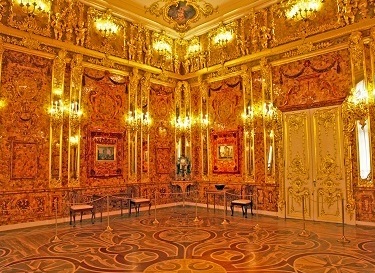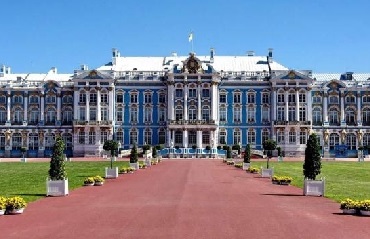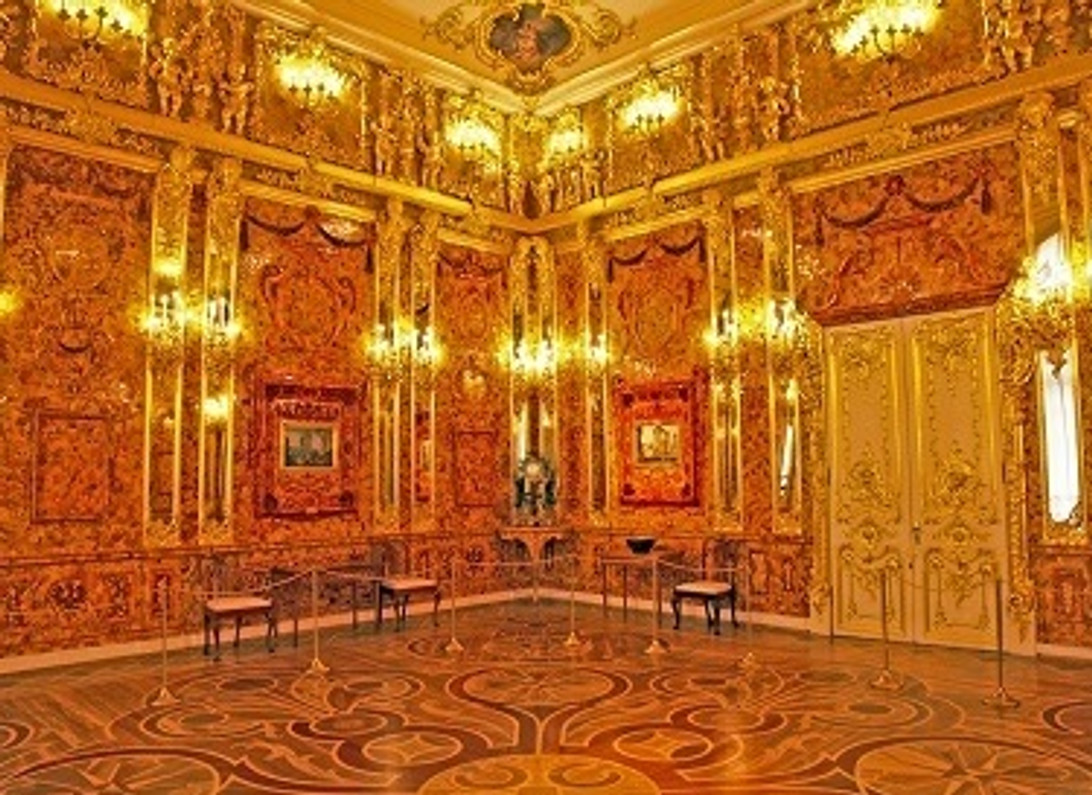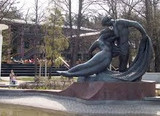The Amber Room.
Creation of The Amber Room.
The Amber Room can be considered as the most remarkable creation from Amber. Not only that, but it is commonly regarded as the most important art piece of Baroque time and even as the most significant world's art treasure. In addition to Amber, this room crafted with various precious stones and even gold. This room was first created in the 18th century and at that time in history it was commonly considered as the 8th Wonder of the World. The King of Prussia (F. William I) gifted this room to Peter the Great in year 1716. During his visit in Prussia, Peter the Great was fascinated by The Amber Room so it given to him as a gift in order to make Russian-Prussian alliance against Sweden stronger.

The entire Amber Room was separated into smaller parts and later it was shipped to Russia. Around 18 large boxes were received and the whole design of this room was reworked in The Winter House, which was located in St. Petersburg. Some years later Czarina Elizabeth, who was a daughter of Peter, decided to move The Amber Room into Catherine Palace (Tsarskoye Selo), which was situated in Pushkin. It was necessary to redesign the room, because the new space was larger. It was done by italian designer B. F. Rastrelli who shipped additional needed Amber from Berlin. The whole family of Peter the Great used to be in this palace during their summers and the Amber Room was important part of their European art collection. For Czarina Elizabeth this room was a place for meditation, Catherine the Great used it as a gathering place and for Alexander II it was a place of trophies. Throughout the years there were different renovations done to the room as well. It is estimated that the entire room might have contained more than 6 tones of Amber and it was about 55 square meters. Based on historians, the value of this room in today's dollars might vary between 142 and 500 million.
World War II.
Word War II was quite unsuccessful period for the Amber Room. After Hitler launched his Barbarossa operation, at least 3 million German soldiers invaded the Soviet Union. One of the aims of this invasion was to find and loot important art treasures from Russia. Since The Amber Room was made by Germans, this treasure was particularly important for Nazis and they wanted to bring it back to their country. Officials in the Catherine castle tried to disassemble this room and hide it. Due to crumbling of dry Amber, officials tried to hide the room by using wallpaper as well. This plan didn't work as expected and as soon as Nazi soldiers reached Pushkin, they found The Amber Room. Quite quickly the soldiers were able to split the room into smaller parts and ship them to Germany.
The new selected location for this room was Konigsberg Castle museum, which was located in Eastern Prussia (Kaliningrad). For the next two years, the room was on display and it was studied by A. Rohde who was German Art historian and a director of the museum. In the end of WWII, it was suggested to A. Rohde to dismantle the room as soon as possible and send it away. Quite soon the Royal Force bombings of the city started and they turned the whole city and museum into ruins. Whether The Amber Room was dismantled or not before the bombings remains unclear even today. The most accepted theory is that Russian artillery destroyed the room once Konigsberg was stormed in year 1945 by the Red Army. Alternative theories suggest that the whole room was spirited away by A. Popp. Based on this theory, The Amber Room was moved to old mines of Nordhausen.
Throughout the years there were various attempts to find the missing Amber room. 1998 one German team made the announcement that they know the location of this room. Their suggested location was a silver mine; however later nothing was found there. A similar attempt was done by Lithuanian team, but The Amber Room wasn't found in their selected lagoon. The most recent news about search of this room was published in 2016. Based on some testimonies, a few searchers became convinced that pieces of The Amber Room were hidden in Hartenstein hills that are located near Dresden. They did digging and radar scans of the place; however so far no findings were announced.
Reconstruction of The Amber Room.

Instead of trying to solve mistery surrounding this room, Soviet government decided to reconstruct The Amber Room. The process began in year 1979 and the location for reconstructed room was selected to be Tsarskoye Selo (St. Persburg). The whole project costed about 11 million dollars and it took 24 years to do. The major issue during reconstruction was lack of skilled workers who knew how to carve Amber properly. Original drawings and photographs from past, allowed experts to make quite close duplicate of the original room. After German based company E. ON donated 3.5 million dollars, financial struggles in this project were overcame. The whole reconstruction work was finished in year 2003. Since a few pieces from the original room survived WWII, Germany returned them to Russia. Both Amber bureau and Florentine Mosaic can be currently found in reconstructed Amber room.
Recent Posts
-
The Amber Room.
Creation of The Amber Room. The Amber Room can be considered as the most remarkable creation from …19th Jun 2018 -
Baltic Amber History and Myths.
AMBER HISTORY. Baltic Amber was used by humankind since the beginning of time (the end of Ice Age) …19th Jun 2018 -
Baltic Amber Benefits.
DOES AMBER HAVE HEALTH BENEFITS?Various health and healing properties were attributed to Baltic Ambe …22nd May 2018




